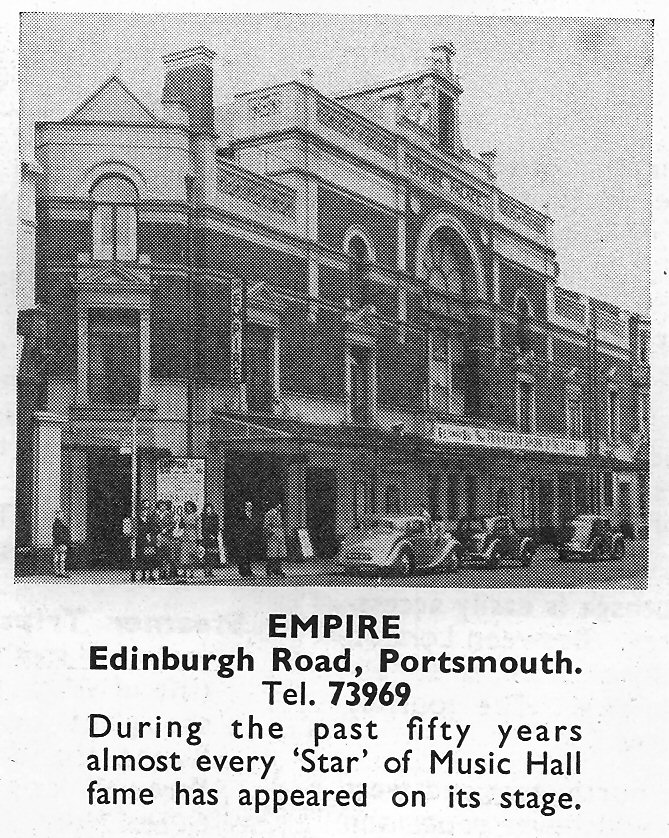

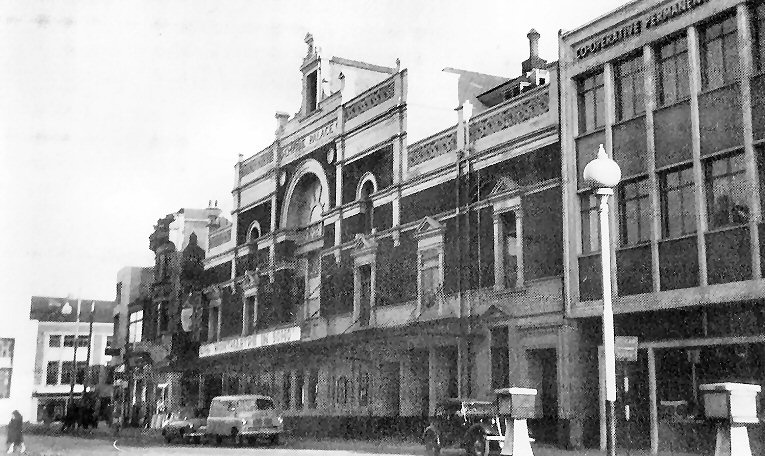
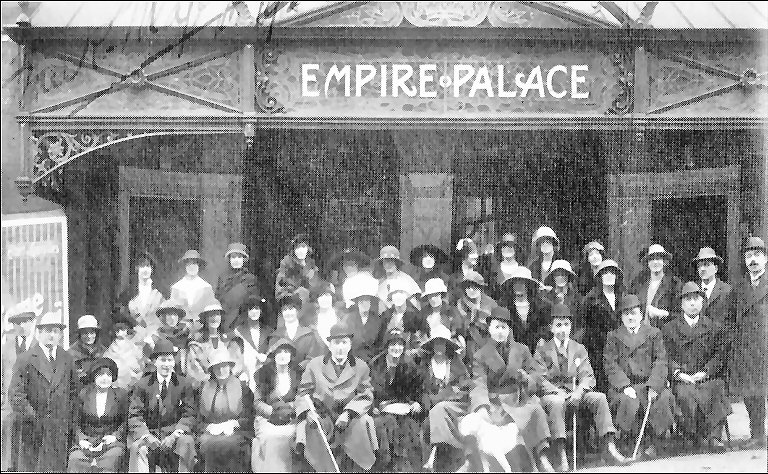
A between the wars cast taking a photo call
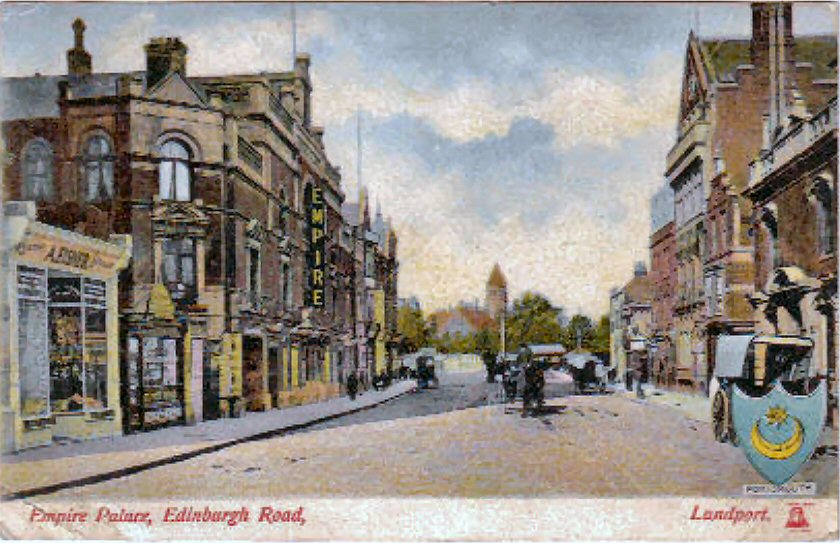
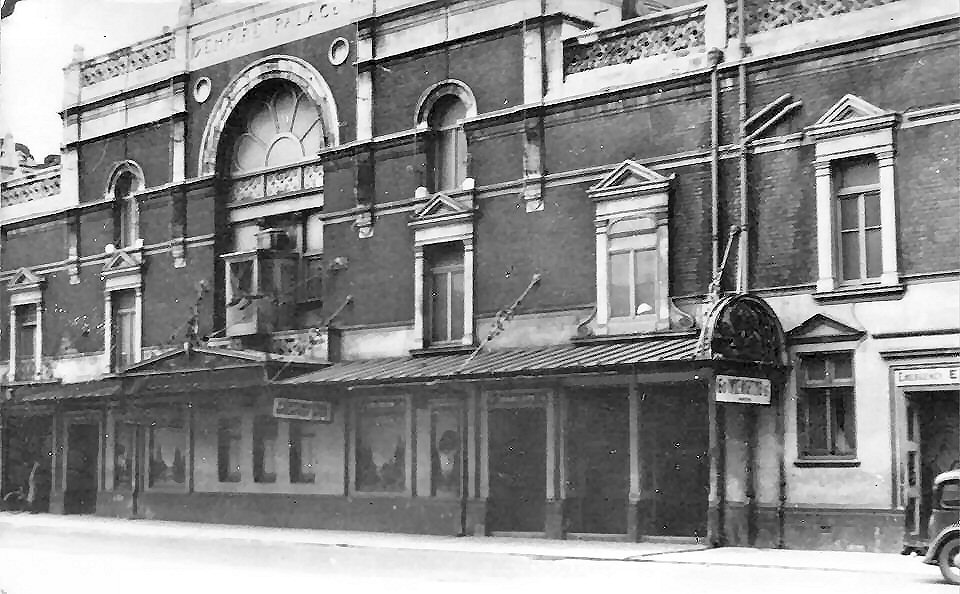
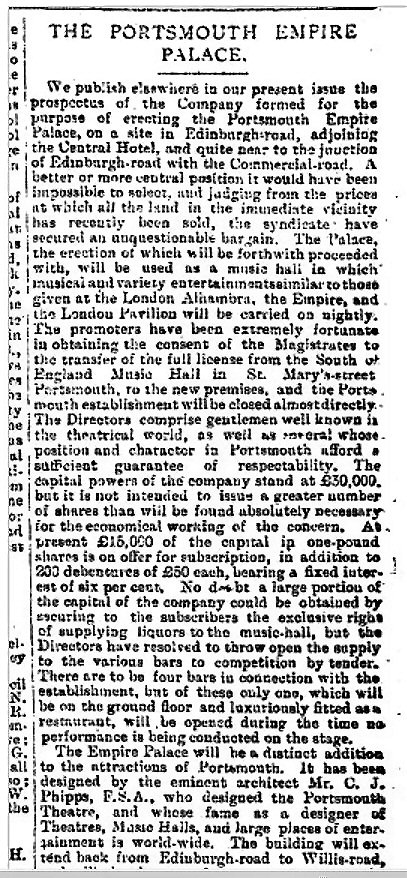
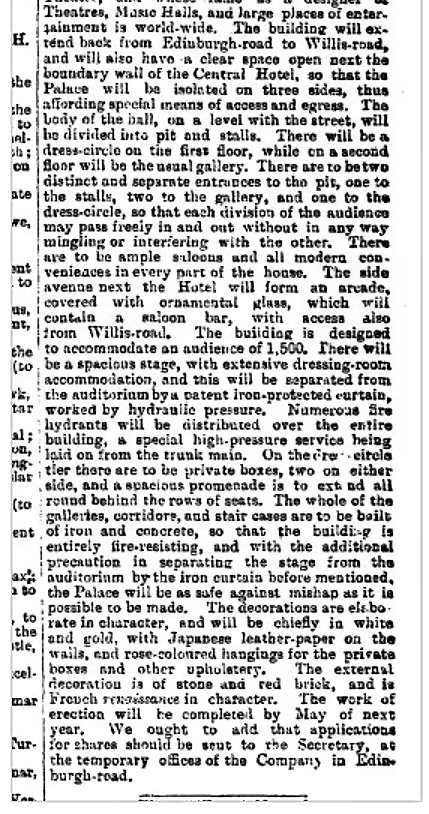
8th November 1890
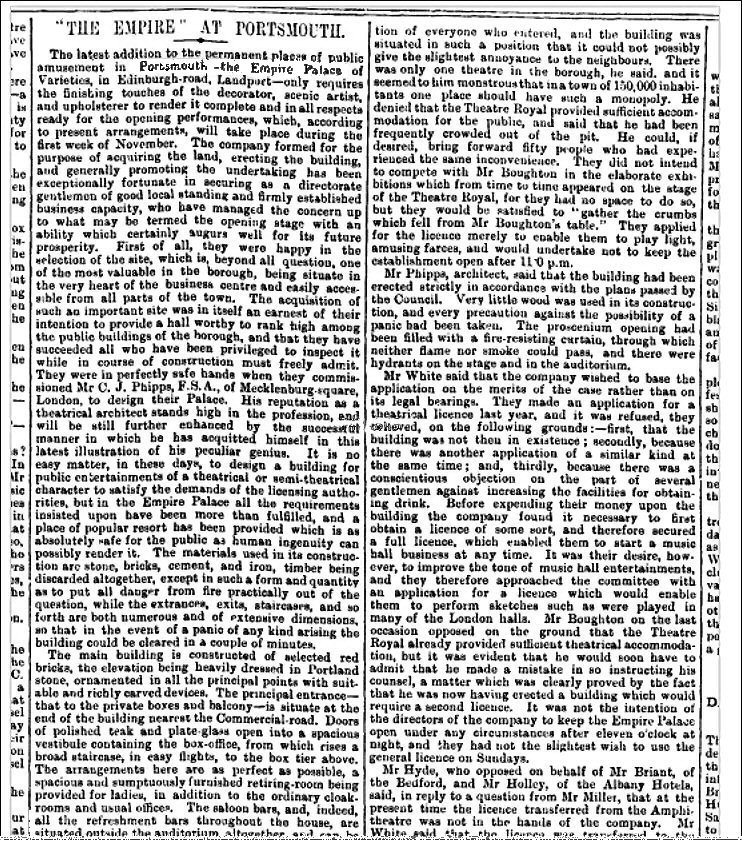
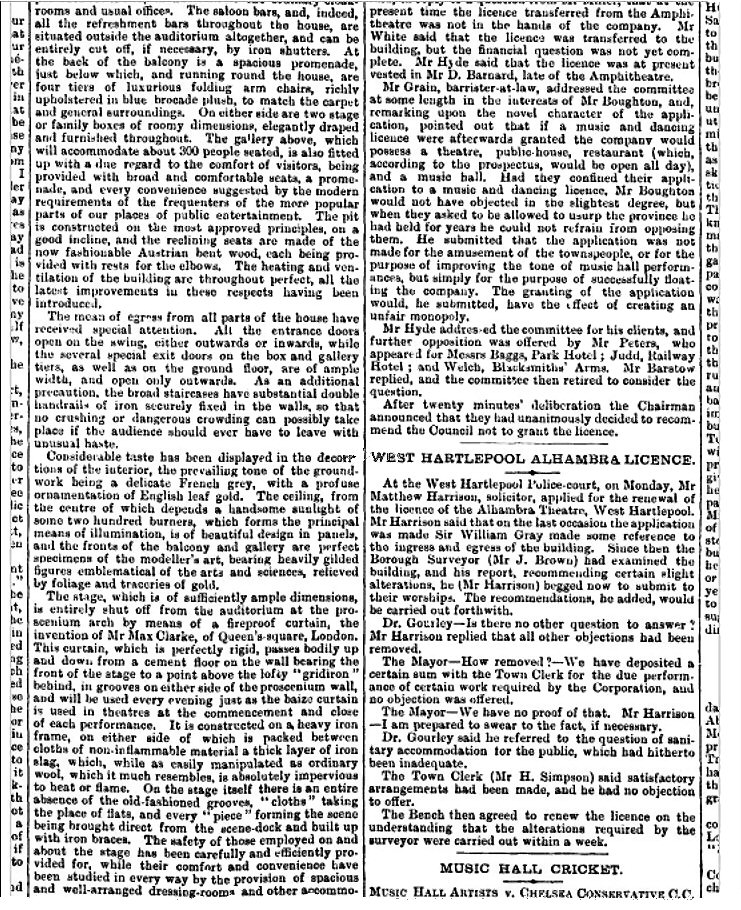
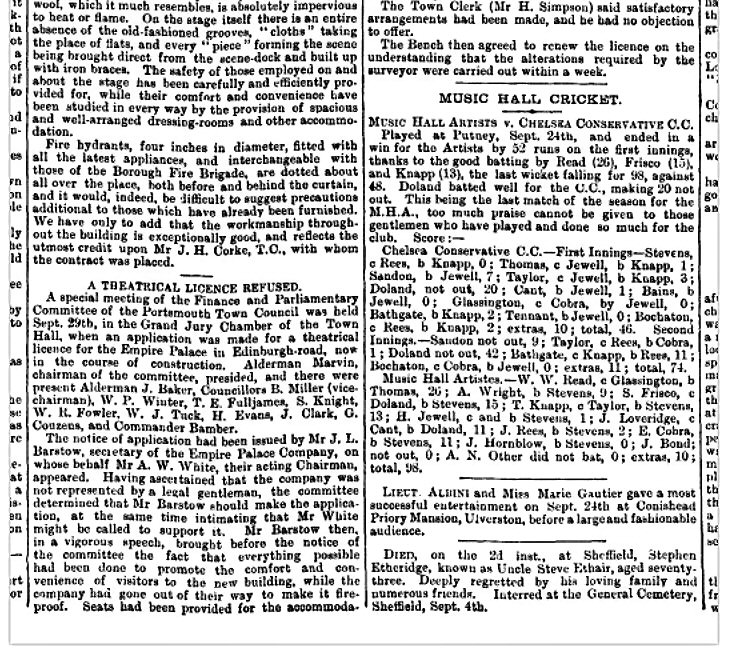
26th December 1890
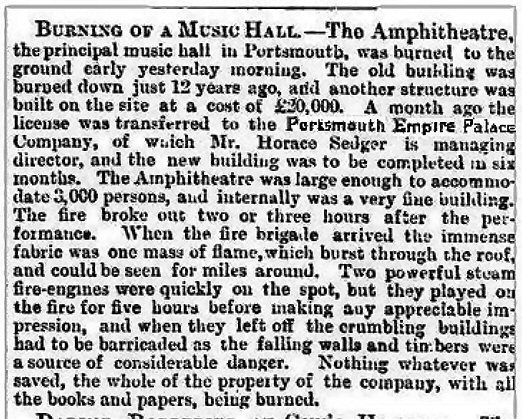
also 26th December 1890

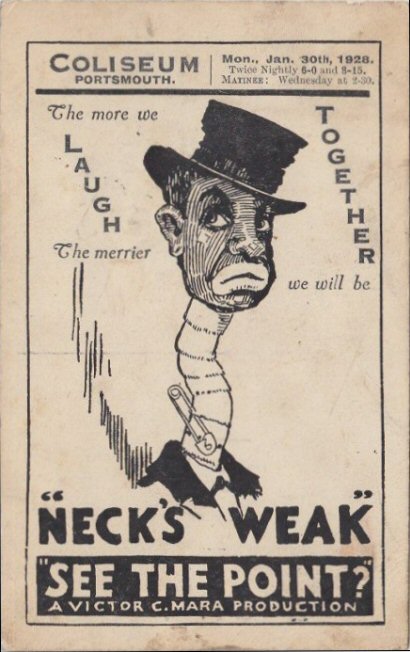
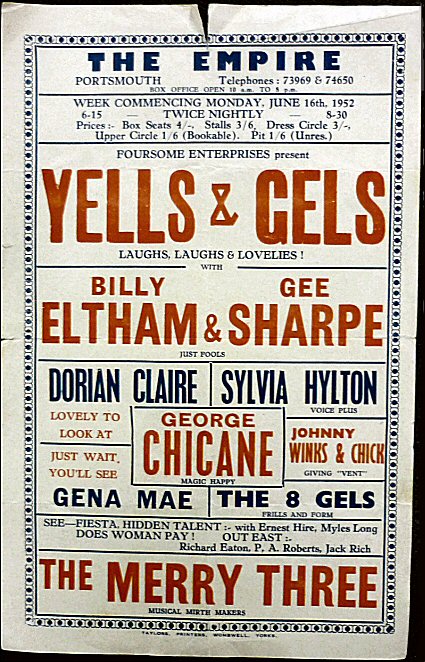
The Portsmouth Empire Palace Company, composed in the main of local business men, commissioned CJ. Phipps to design the theatre, and Cooke of Fratton to construct it.
The grand opening was on the 2nd November 1891. A full house of 800 seated and 300 standing enjoyed a varied bill which included acrobats, dancers, a comedian, a banjo player, songs, comedy sketches and 'living marionettes'.
The Portsmouth Times gave a detailed account of the theatre. Great attention had been paid to safety especially from fire. Phipps must have been especially conscious of this hazard, for his Exeter Theatre
Royal had been destroyed by fire, shortly after its opening in 1886, with considerable loss of life. The Court had levelled serious criticisms at his design.
The Empire, built of brick, had two cantilevered tiers with an iron framework and concrete flooring. A massive wall, with an iron-framed safety- curtain, separated stage and auditorium. These precautions
are now statutory, but were not so in the past.
The Empire marked an evolution in music-hall design, which previously had been completely different from that of the legitimate theatre. As mentioned earlier they often originated in a Tavern, like the
South of England Music Hall, and were merely a large room or hall, sometimes with a small balcony. By the late 19th century, all that was changing, and the new music-halls, or variety theatres as they were
becoming known, resembled more and more the straight drama houses. The stage might be smaller,
with fewer technical facilities, and the decor perhaps relatively a little 'vulgar'!
It is interesting to observe how the wheel of Music Hail has turned full circle; it developed as a 'pub' entertainment, and evolved into Variety played in Grand's and Empires. They, in their turn, have
Disappeared, and 'variety "has returned to taverns and, especially in the north, to Clubs.
It "as a sign of these chances, that the Company managed to secure Phipps as their architect for he was more accustomed to design the grand, beautiful opera houses, rather than a small music hall.
The ground floor had comfortable seats with armrests, whilst the balcony (first tier) had most luxurious seats, upholstered in blue figured plush whet. On audience right there "as a large promenade and
saloon, an echo of the old music-hall. Two boxes separated the balcony each sine from the proscenium arch. Together with the gallery (second tier), the theatre could seat 800 with another 200 standing.
It was a square-shaped auditorium, with a prevailing colour -home of blue-grey, ivory and gold leaf. (All theatres seemed to have been able to adorn their theatres with libraries of gold leaf: sadly gold' paint
has to suffice nowadays, l he panels of the tiers were originally adorned with mythological figures, whilst the ceiling had an elaborate rococo pattern, spraying out from the centre sunlight. Initially, the
auditorium was lit by gas, the mantles being enclosed b\ opal shades. The sunlight a multiple jet gas burner, gave both illumination, and with a true above it, helped to extract the obnoxious fume, (and
other pungent odours!) which plagued gas lit theatres. Trapeze fittings were permanently attached to the Ceiling, and wire supporting_ ropes could be attached to the gallery. Phipps must have winced at
such plebeian disfigurement to his carefully designed auditorium!

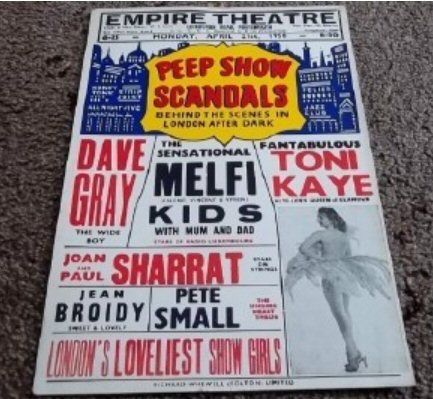 Patronage must base been drawn from that of the old Halls, such as the South of England, Ginnet's Hippodrome and others which were no more. Seats cost more, but were considerably cheaper than those at the Royal or Princes. Private boxes were 1 guinea and half a guinea, balcony 2/-, hall (i.e. ground floor) Hand the gallery 6d.
In 1900, the Empire Palace Company planned to build a new super theatre on the west side of Stanhope Road, on the site of the present Zurich building. It was to have a frontage of 200 feet, and a depth of 80
feet, with three tiers. The magistrates refused a licence for the projected theatre, and the plan was dropped. However, in 1913 the old theatre was completely renovated, and renamed the Coliseum.
Evidently, the management were feeling increased competition from the Hippodrome and Kings Theatre, both new and splendid theatres, and both presenting variety at this time.
The Portsmouth Times reported that the auditorium was redecorated, and the plaster highlights picked out in real English gold leaf. Two boxes were added each side of the gallery and three rows of
fauteuils introduced in front of the stalls. The entrance foyer and staircases received embellishments of ornamental plaster work, and hand-painted figures adorned the panels. Commissionaires, in
magnificent new uniforms, and "a waiting staff of daintily attired waiting maids" greeted patrons.
Patronage must base been drawn from that of the old Halls, such as the South of England, Ginnet's Hippodrome and others which were no more. Seats cost more, but were considerably cheaper than those at the Royal or Princes. Private boxes were 1 guinea and half a guinea, balcony 2/-, hall (i.e. ground floor) Hand the gallery 6d.
In 1900, the Empire Palace Company planned to build a new super theatre on the west side of Stanhope Road, on the site of the present Zurich building. It was to have a frontage of 200 feet, and a depth of 80
feet, with three tiers. The magistrates refused a licence for the projected theatre, and the plan was dropped. However, in 1913 the old theatre was completely renovated, and renamed the Coliseum.
Evidently, the management were feeling increased competition from the Hippodrome and Kings Theatre, both new and splendid theatres, and both presenting variety at this time.
The Portsmouth Times reported that the auditorium was redecorated, and the plaster highlights picked out in real English gold leaf. Two boxes were added each side of the gallery and three rows of
fauteuils introduced in front of the stalls. The entrance foyer and staircases received embellishments of ornamental plaster work, and hand-painted figures adorned the panels. Commissionaires, in
magnificent new uniforms, and "a waiting staff of daintily attired waiting maids" greeted patrons.
Marie Lloyd topped the bill at the gala re-opening. Whilst such stars were not always on the bill, a wide variety of popular acts were presented, and the theatre prospered. In the 1930s, a Christmas
pantomime became a regular event; they were very traditional, with plenty of 'custard-pie' action! In 1933, .there was a resident repertory company doing twice nightly shows; this venture only lasted a few
weeks, and was not repeated.
In 1941, its old rival, the Hippodrome, was destroyed, and the Kings had gone over to straight theatre. After the War, the theatre was again re-decorated, re-seated, re-curtained and the gallery side boxes
were removed. Perhaps this was to answer competition
from the Royal, which became a variety theatre in 1948. Once more, in 1950 it reverted to its original name, the Empire, and it became the cleanest and most comfortable theatre in the city. For a few years it
flourished, until by the mid-1950s, when television invaded the south, and there were fewer and fewer good acts on the road. Even the "We never clothe 'em" shows failed to draw audiences. It had a few
moments of strange, final, partial glory, when the Portsmouth Grand Opera Company presented `Faust' and `Die Fledermaus' in 1957 and 1958.
The end came in September 1958, when it was sold and demolished, and a supermarket was erected on the site. It was tragic that a fine Victorian Theatre, designed by one of the best theatre architects,
should have been destroyed. Its size, facilities and location would have made it an ideal venue for many cultural purposes, which have hitherto lacked a base in the city.
It was said that the licensee tried to lease the Theatre Royal, which at that time was closed.
Technical Data
Stage depth 21 feet,
Proscenium Opening 28 feet,
Width of Auditorium 56 feet,
Depth of Auditorium 54 feet Two tiers - balcony and gallery,
All the bars and saloons were on audience right,
Charlie Chaplin made his stage debut here in 1899 when he did a tryout week with the "Eight Lancashire Lads" which was a troupe of clog dancing children. Norman Wisdom also made his professional debut there in the late 1940's.
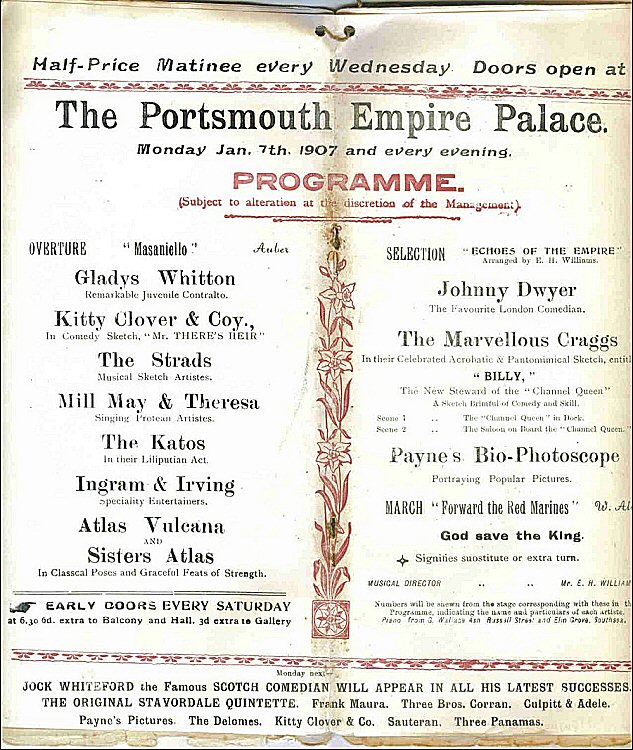
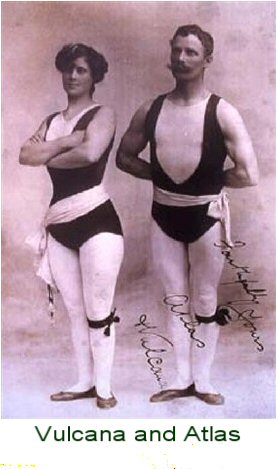
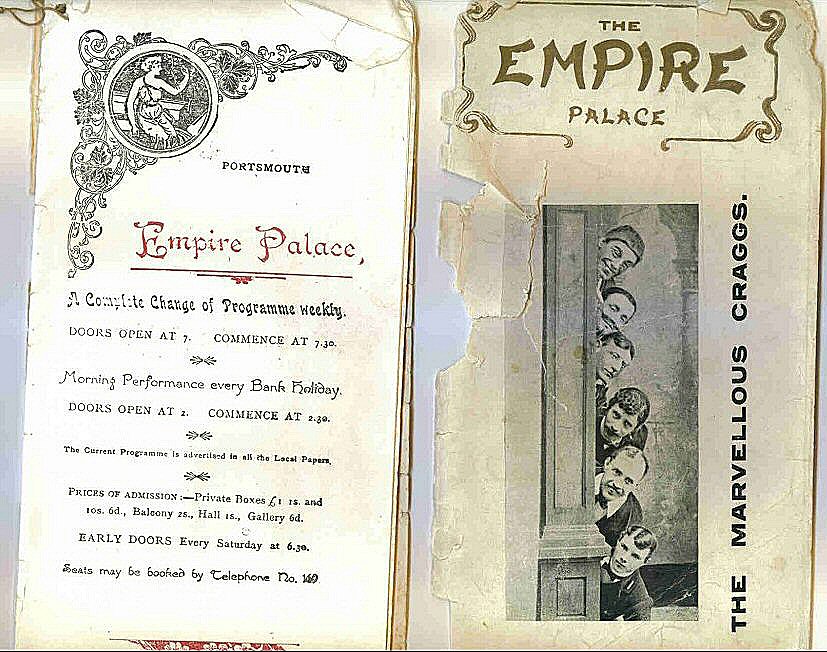
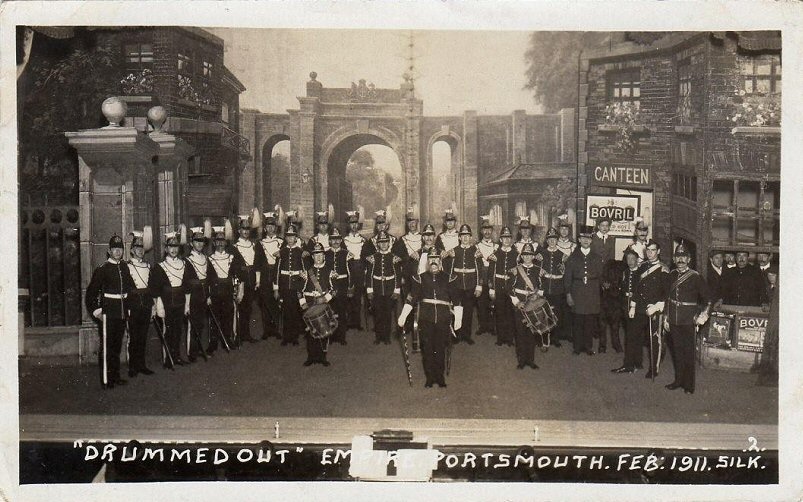
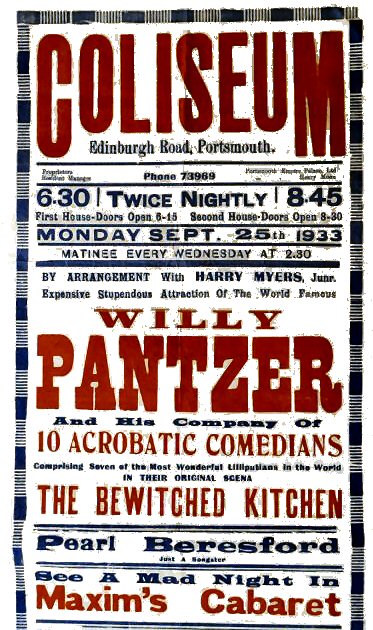
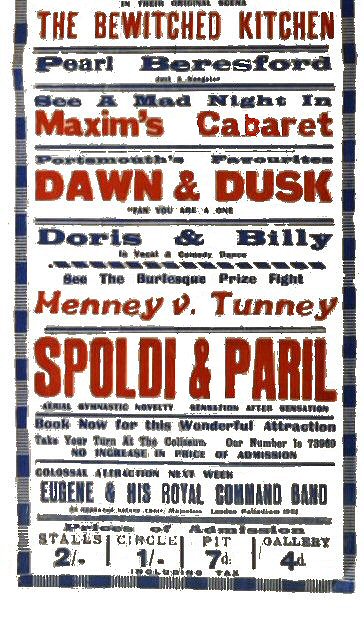
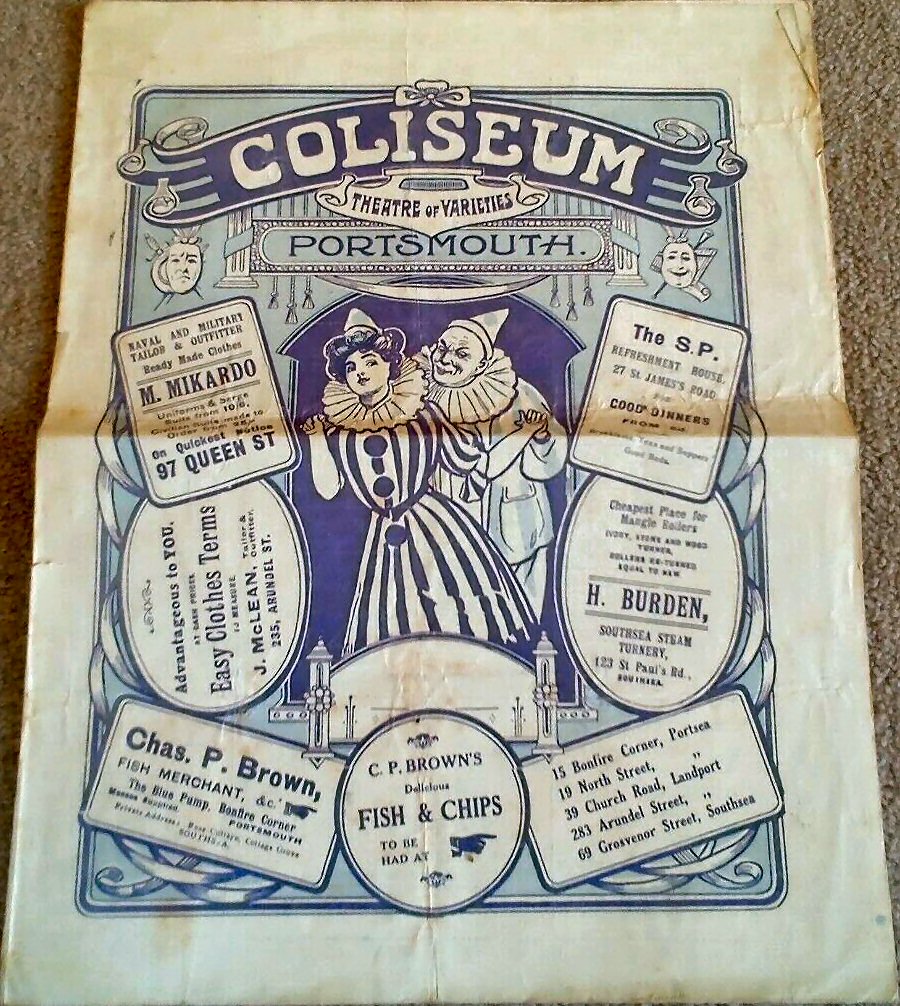
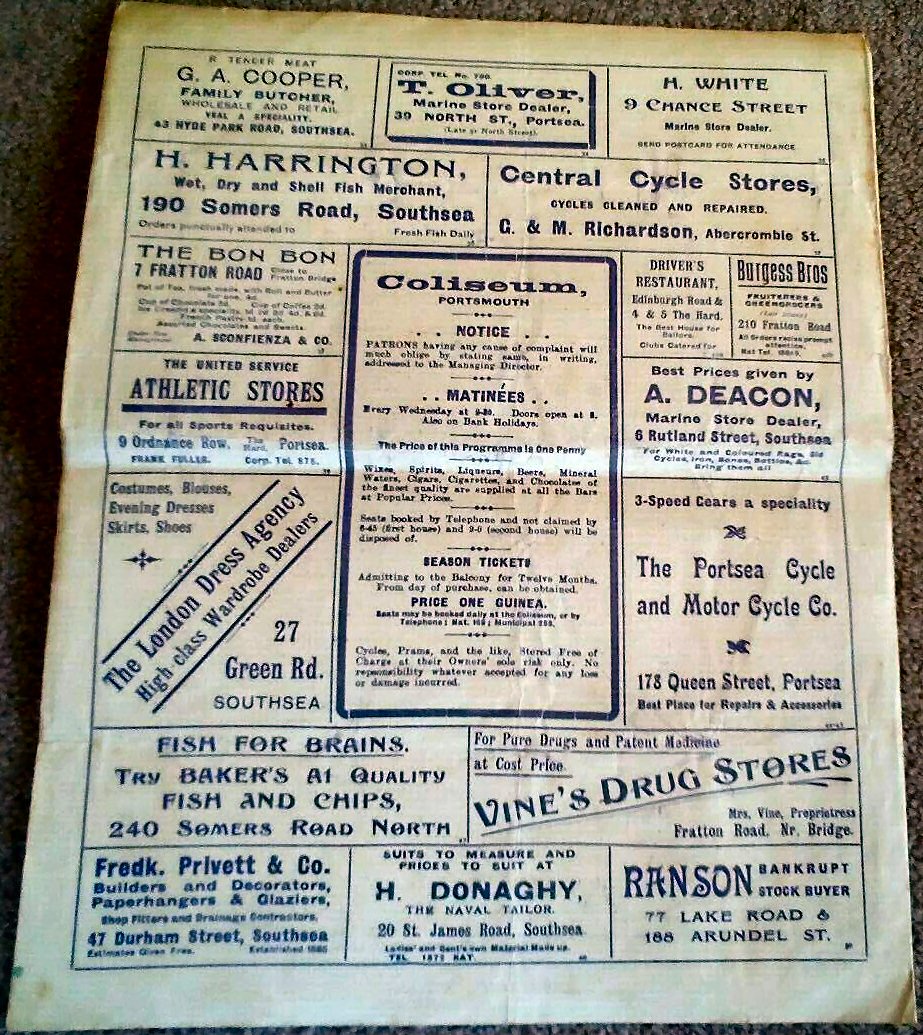
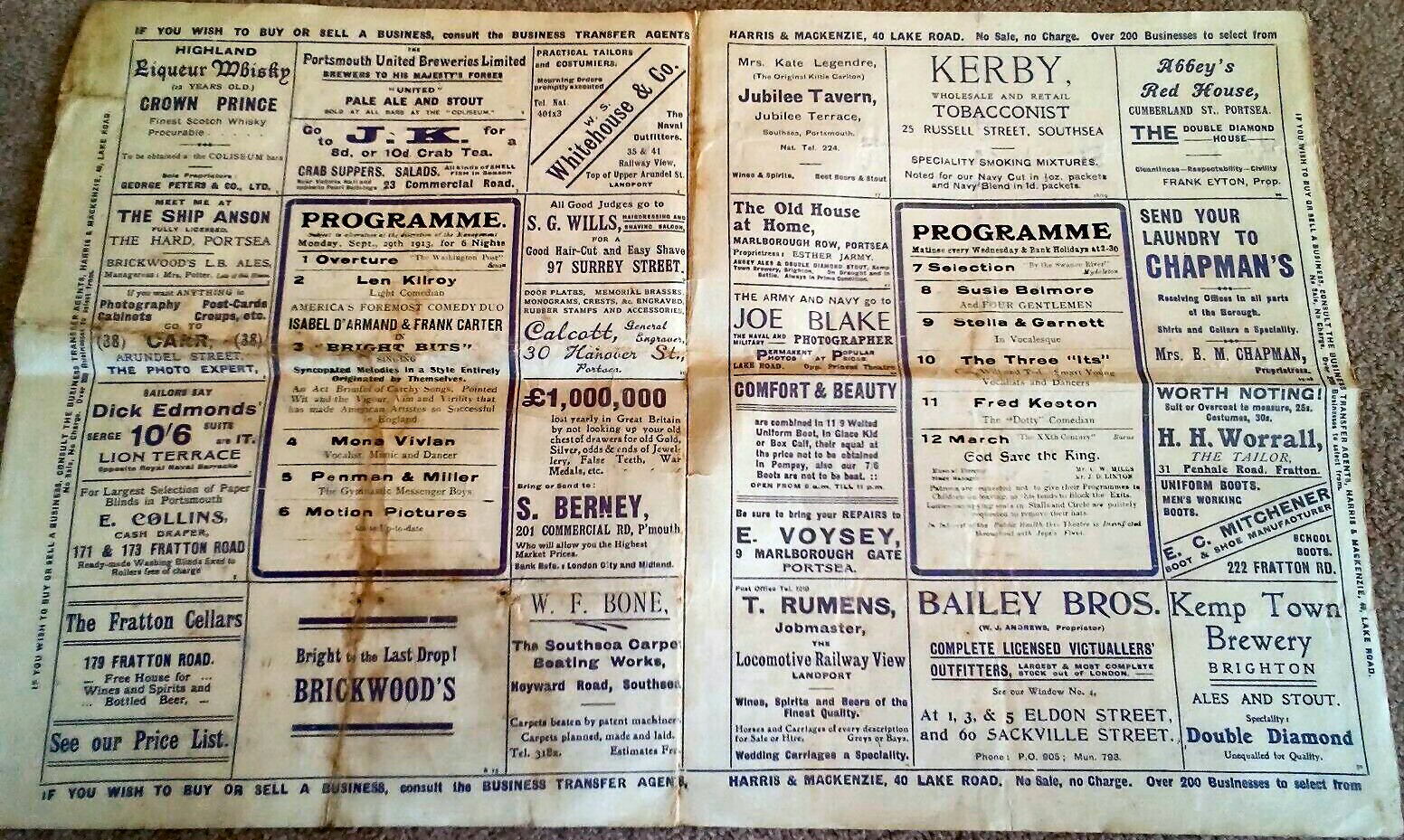
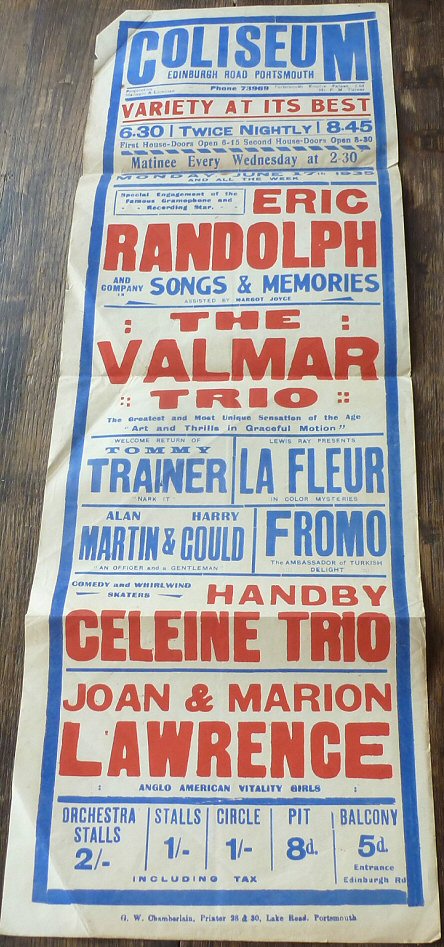

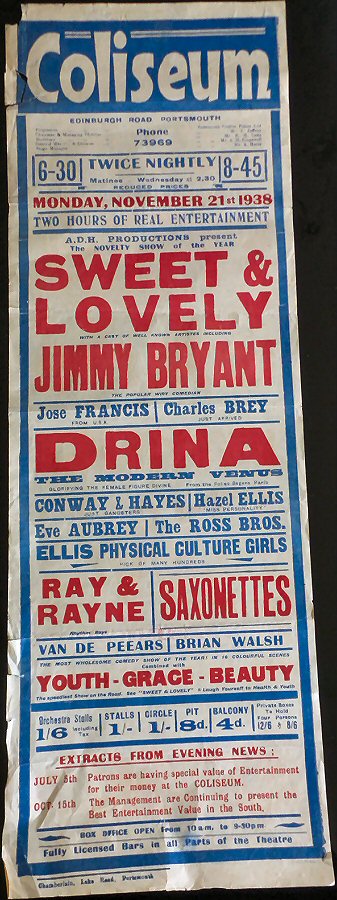
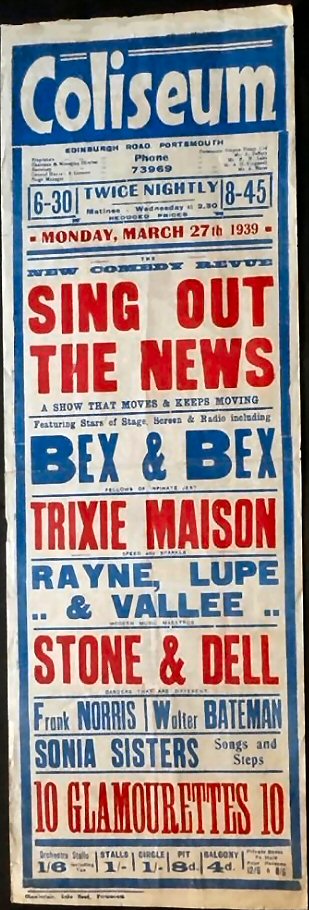
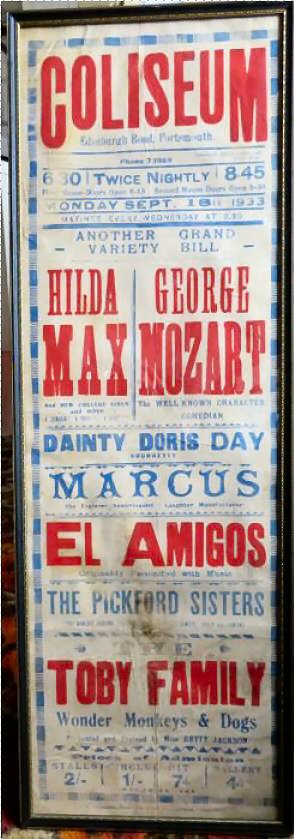
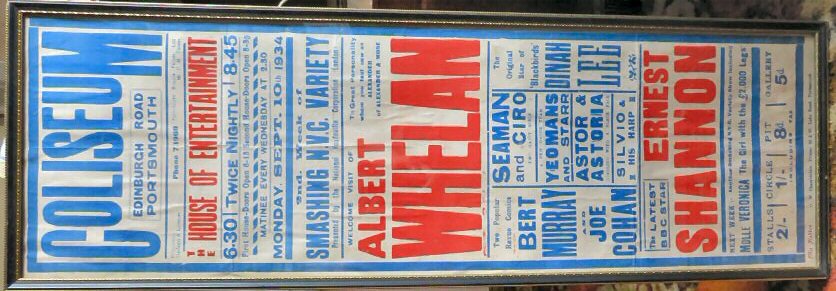
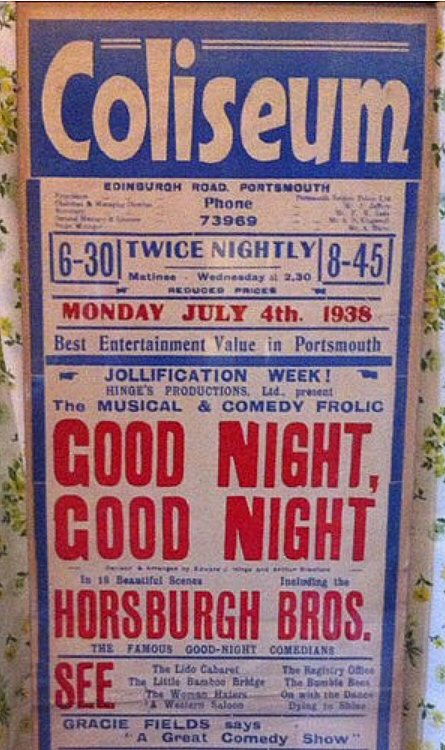
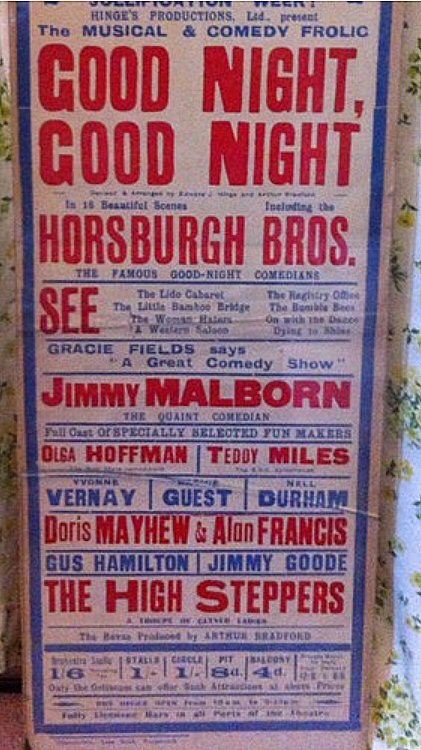

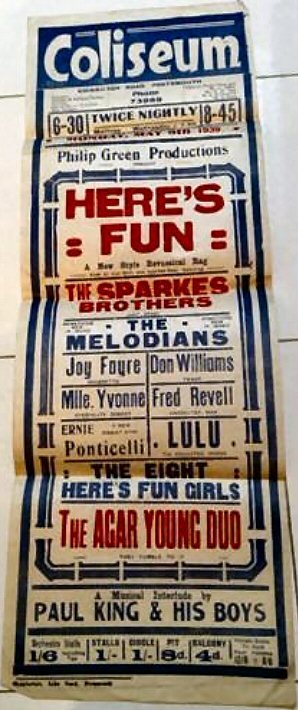
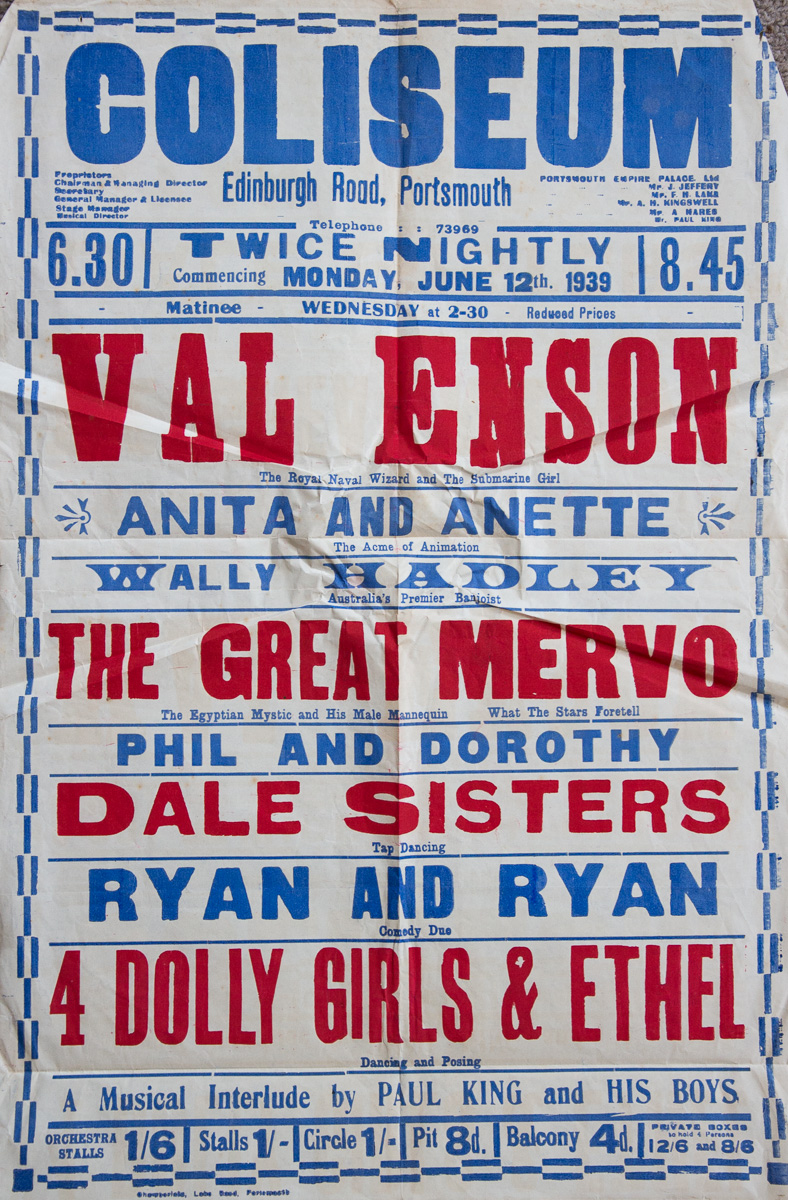
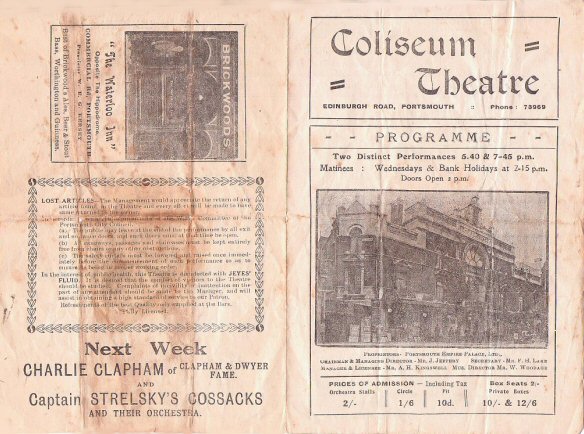
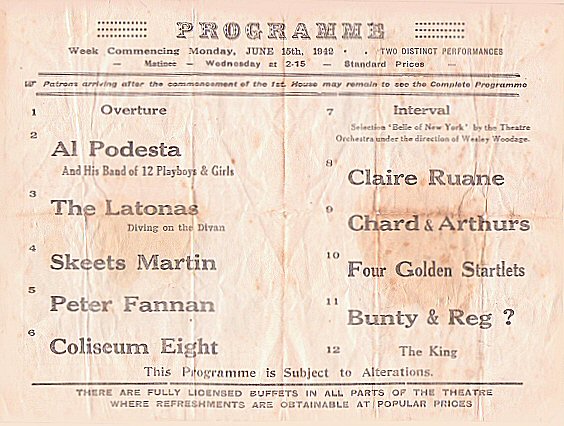
16th November 1942. Those appearing are Connor & Drake, Bobby Wright & Marion, Four Stooges, The Zio Anglels, Troy Sisters & Wilson, Prescilla Wise and Arthur Dove.
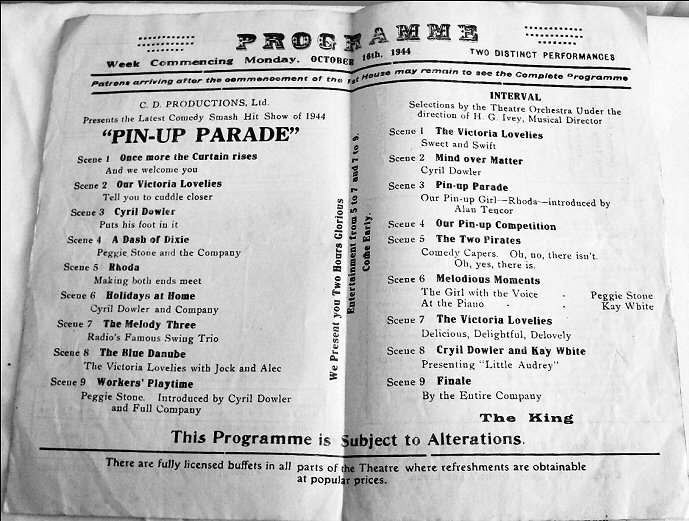
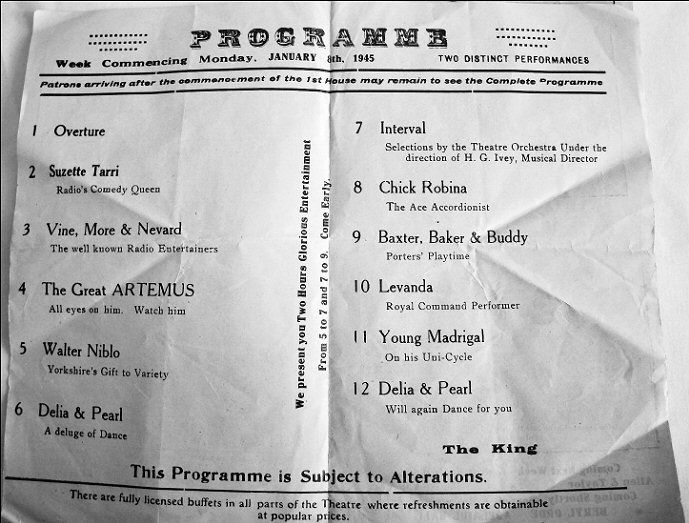
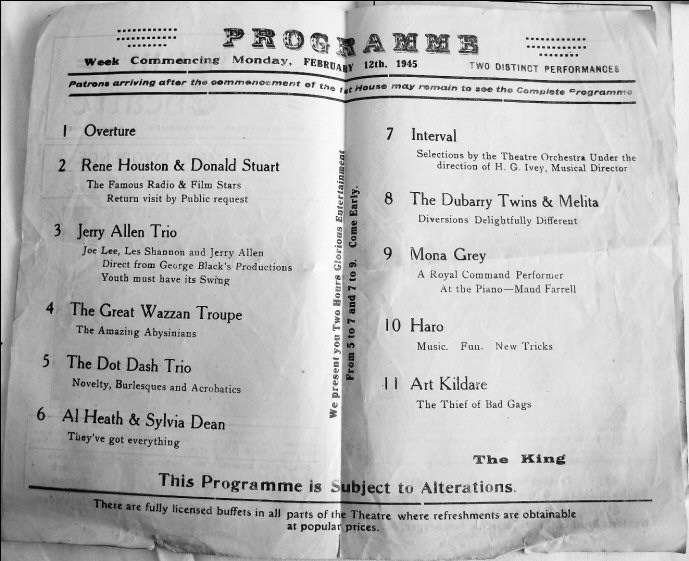


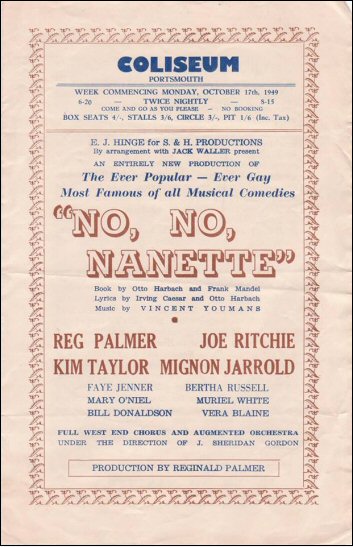
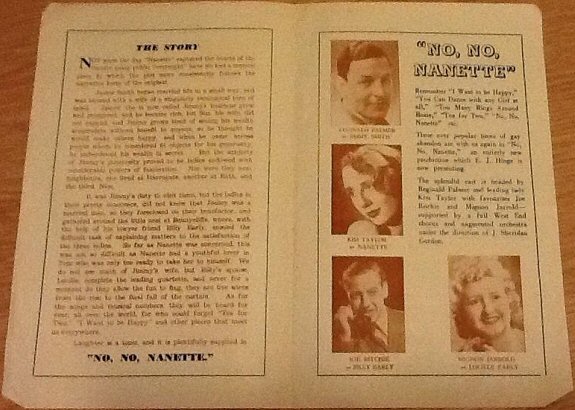
from 1949
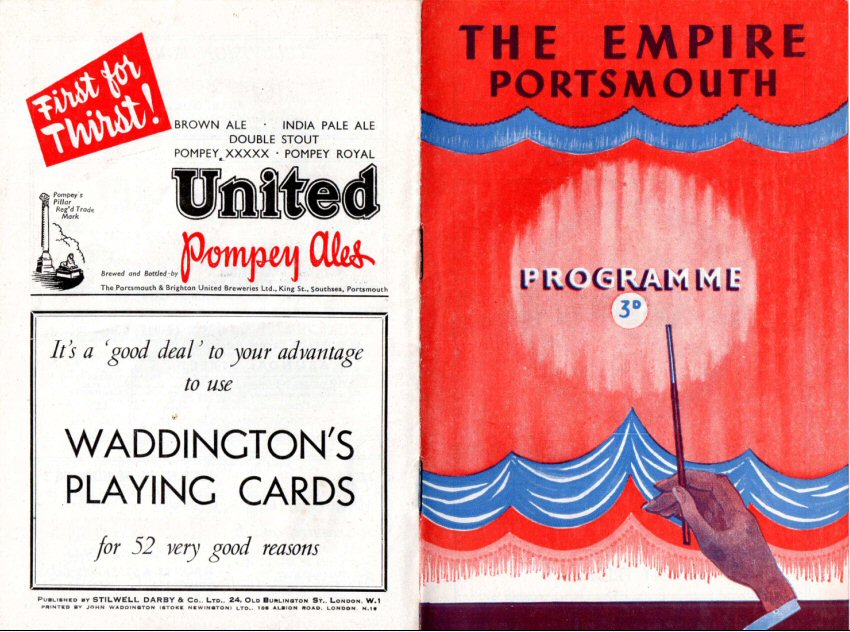
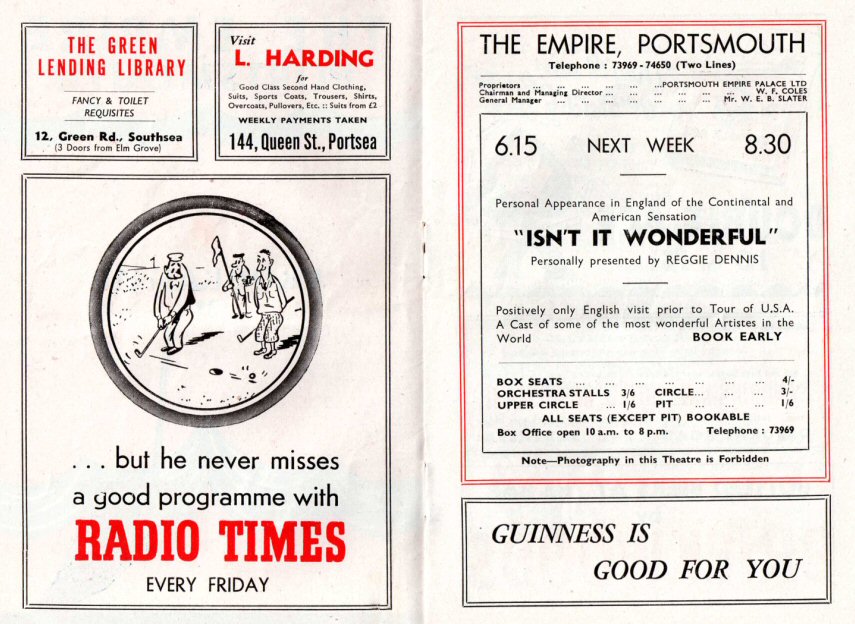
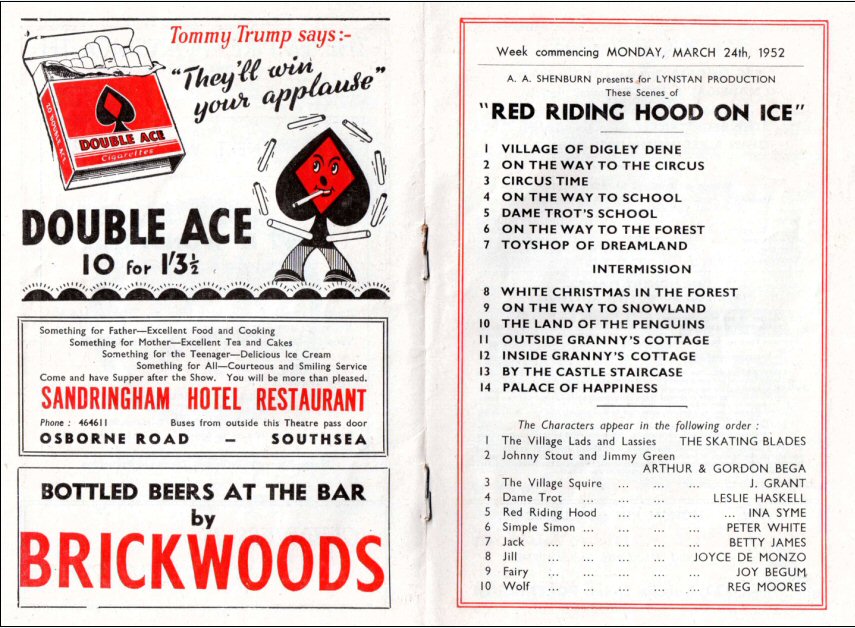
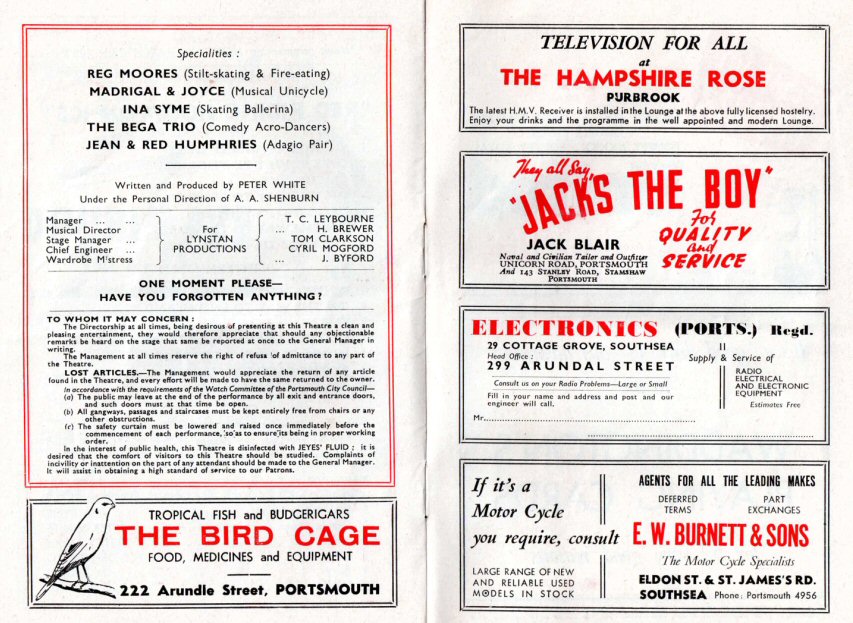
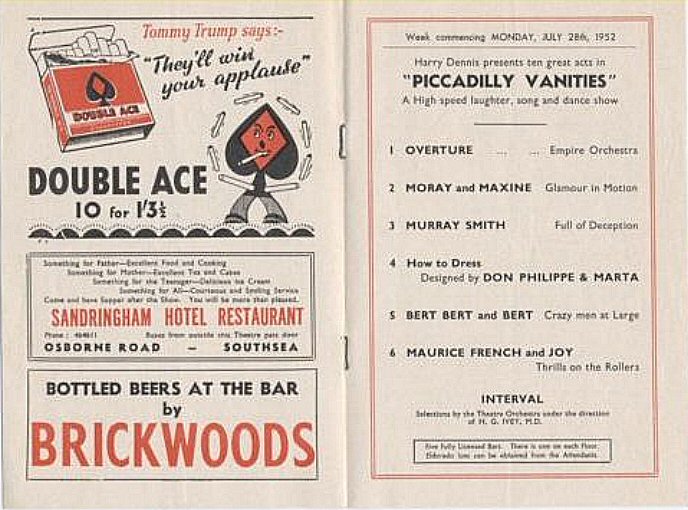
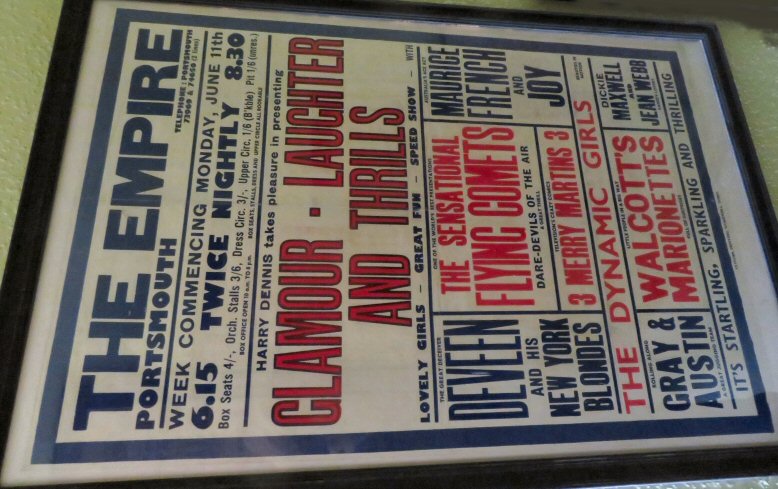
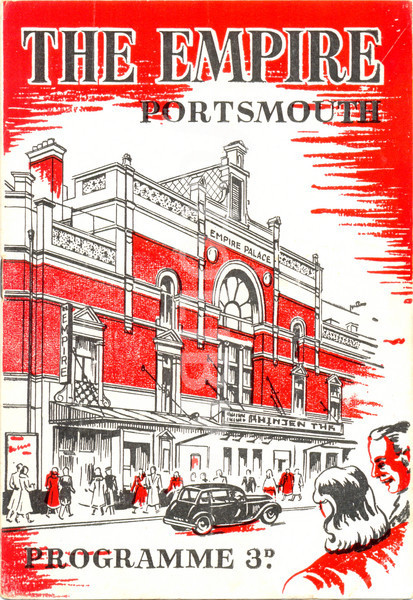
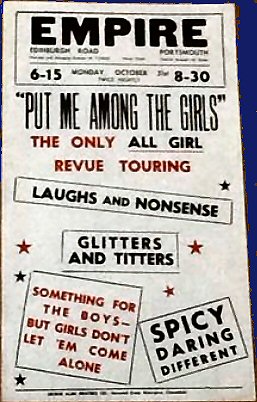
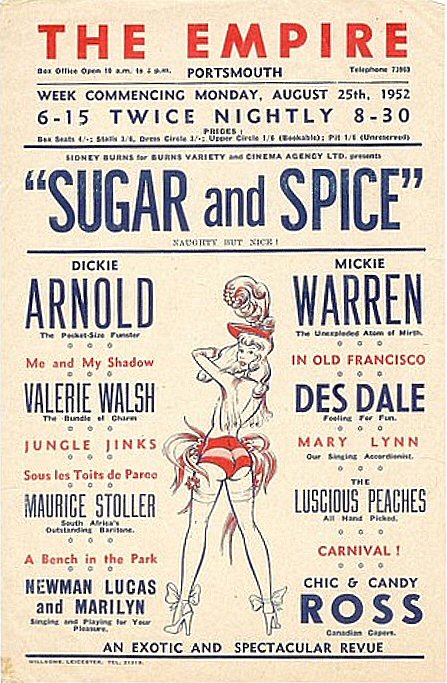
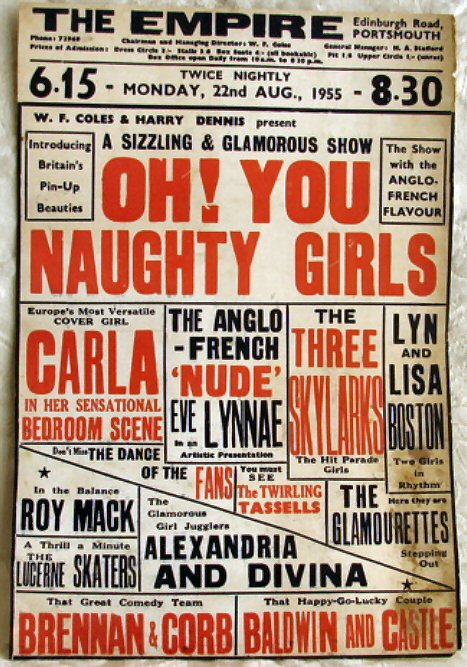
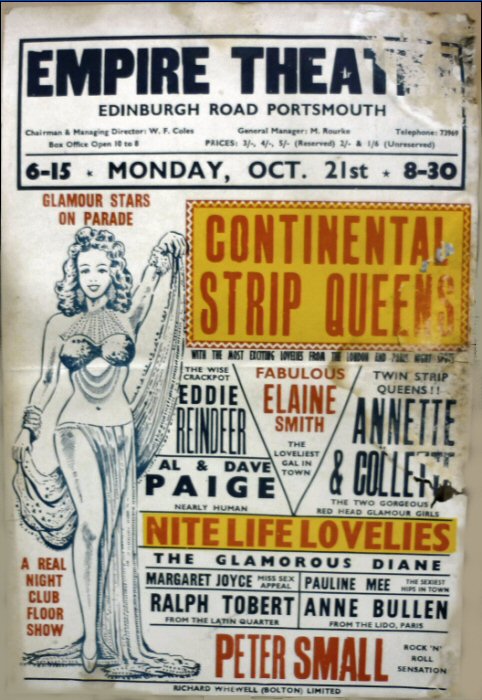
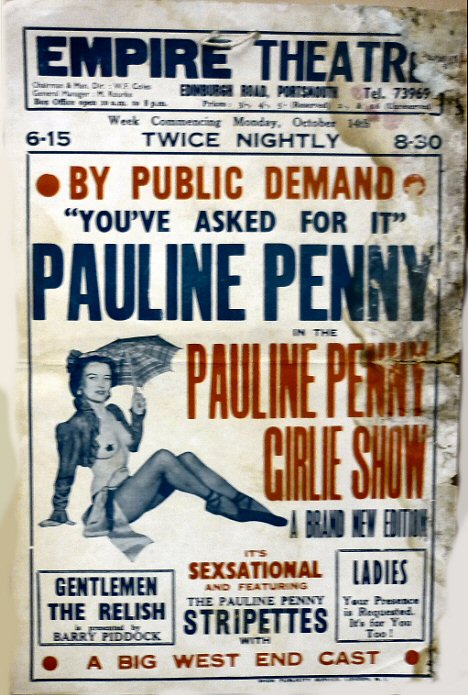
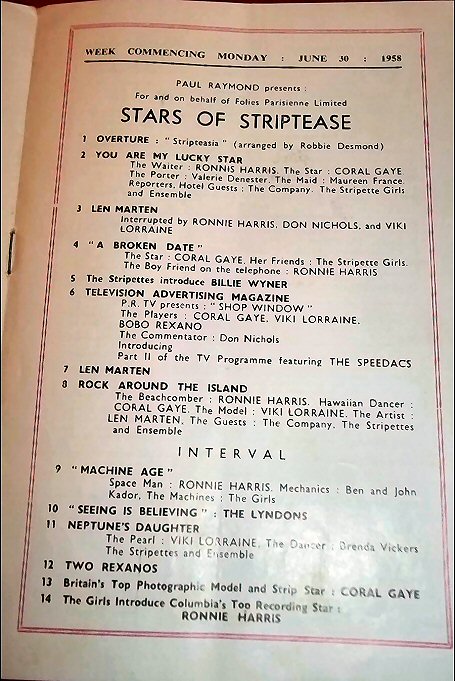
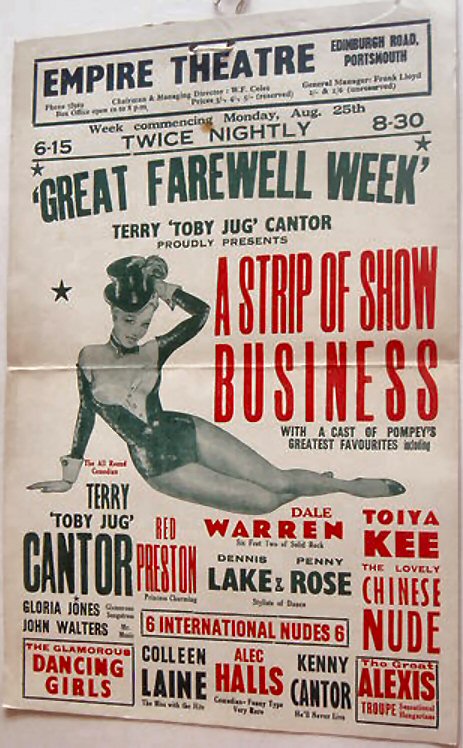
The final week of the Empire 25th August 1958
|
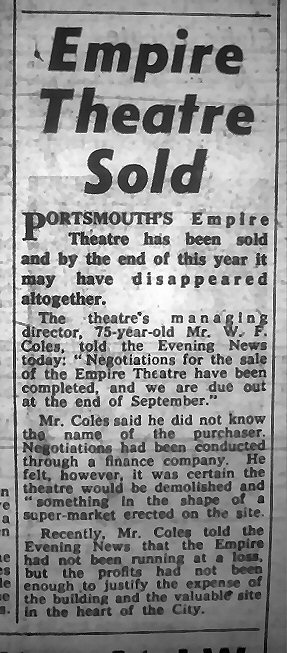
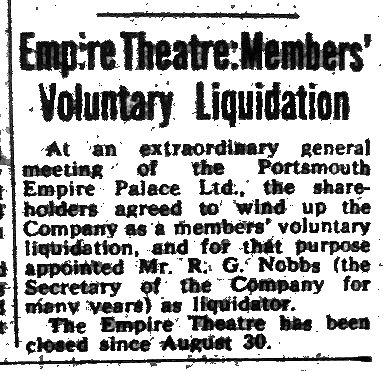
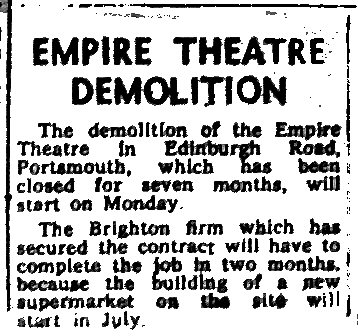
|




















 Patronage must base been drawn from that of the old Halls, such as the South of England, Ginnet's Hippodrome and others which were no more. Seats cost more, but were considerably cheaper than those at the Royal or Princes. Private boxes were 1 guinea and half a guinea, balcony 2/-, hall (i.e. ground floor) Hand the gallery 6d.
In 1900, the Empire Palace Company planned to build a new super theatre on the west side of Stanhope Road, on the site of the present Zurich building. It was to have a frontage of 200 feet, and a depth of 80
feet, with three tiers. The magistrates refused a licence for the projected theatre, and the plan was dropped. However, in 1913 the old theatre was completely renovated, and renamed the Coliseum.
Evidently, the management were feeling increased competition from the Hippodrome and Kings Theatre, both new and splendid theatres, and both presenting variety at this time.
The Portsmouth Times reported that the auditorium was redecorated, and the plaster highlights picked out in real English gold leaf. Two boxes were added each side of the gallery and three rows of
fauteuils introduced in front of the stalls. The entrance foyer and staircases received embellishments of ornamental plaster work, and hand-painted figures adorned the panels. Commissionaires, in
magnificent new uniforms, and "a waiting staff of daintily attired waiting maids" greeted patrons.
Patronage must base been drawn from that of the old Halls, such as the South of England, Ginnet's Hippodrome and others which were no more. Seats cost more, but were considerably cheaper than those at the Royal or Princes. Private boxes were 1 guinea and half a guinea, balcony 2/-, hall (i.e. ground floor) Hand the gallery 6d.
In 1900, the Empire Palace Company planned to build a new super theatre on the west side of Stanhope Road, on the site of the present Zurich building. It was to have a frontage of 200 feet, and a depth of 80
feet, with three tiers. The magistrates refused a licence for the projected theatre, and the plan was dropped. However, in 1913 the old theatre was completely renovated, and renamed the Coliseum.
Evidently, the management were feeling increased competition from the Hippodrome and Kings Theatre, both new and splendid theatres, and both presenting variety at this time.
The Portsmouth Times reported that the auditorium was redecorated, and the plaster highlights picked out in real English gold leaf. Two boxes were added each side of the gallery and three rows of
fauteuils introduced in front of the stalls. The entrance foyer and staircases received embellishments of ornamental plaster work, and hand-painted figures adorned the panels. Commissionaires, in
magnificent new uniforms, and "a waiting staff of daintily attired waiting maids" greeted patrons.








































